#amonkhetu gods
Explore tagged Tumblr posts
Note
So I just had a thought… Nothing stays dead on Amonkhet due to the curse of wandering, right? So what became of all the Phyrexians that died on the plane?
Real answer, we don't know. But there's many factors as play here. After Elesh Norn's defeat, the remaining Phyrexians didn't die proper but went deactivated or went into a coma of some sort, though I imagine some could have been slaughtered from there.
Phyrexia itself doesn't shy for necromancy, seeing it very practically as the equivalent to life, as long as it's more or as efficient and useful. As a result, many phyrexians are partly necromantic already, which might hinder the Curse of Wandering bringing them back again.
Furthermore, Lazotep, the mineral aiming and focusing the Curse of Wandering, seems to reduce the effect of the oil, at least smothering its information and communication capabilities, as mentioned by Lazotep Convert.

The Insectile Gods reshaped by Bolas to prepare his Eternal Army attacked the Phyrexians on sight, allying with the Amonkhetu survivors to do so. It is unknown whether that's a bit of leftover programming from Bolas to protect his interests in case of Phyrexian incursion, a remain or slow return of the Gods' previous life as protectors of their people, or something else entirely, like the plane itself from which the Gods and the Curse of Wandering are formed rejecting this alien form of life and undeath.
But I'm not enough of an expert to state anything with confidence. There are lots of factors, and lots of unknown. It's probably fine, though, Amonkhet had less to offer than most planes and is actively hostile to a building phyrexian force in a way few other planes are (Ikoria and its crystals comes to mind).
26 notes
·
View notes
Text
MTG Weekly Tumblr Recap: April 17th
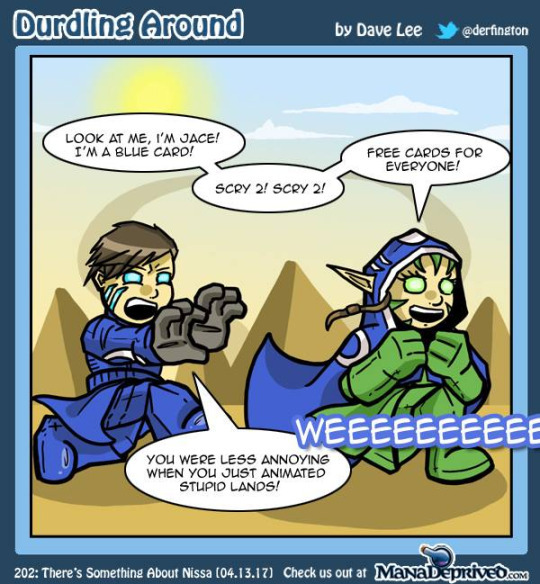
202: There’s Something About Nissa (04.13.17) | Durdling Around
Welcome to this week’s subtly blue-mana infused edition! So many things to look at this week, including a look at the spoilers for Amonkhet, more of the Gods and the Planeswalkers that love them, this week’s Magic Story, “The Writing on the Wall,” as well as a minor revision that echoed loudly. And as always there has been some great fan-art from many wonderful artists. Join us under in the desert paradise that is this issue of the Magic: the Gathering Weekly Tumblr Recap.
1. Spoilers for Choice
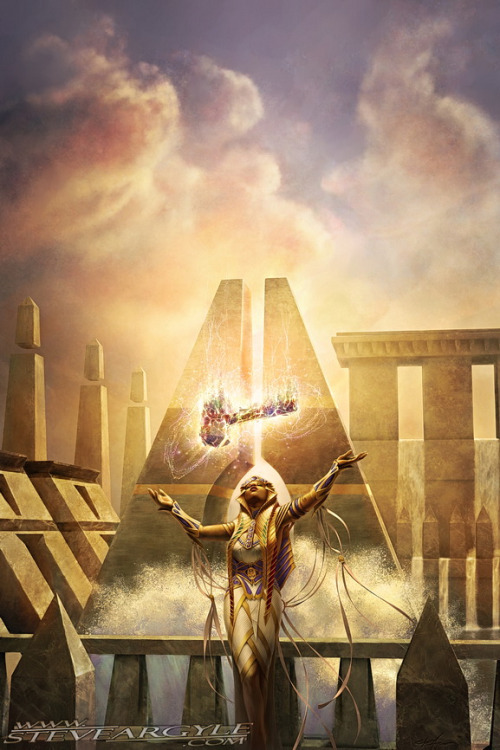
Forsake the Worldly | Original MTG art by @steveargyle
Wow! The second and final week of Amonkhet spoilers came upon us like a sandstorm. The Amonkhetu pantheon of deities has been filled out with cards for Oketra, Rhonas and Bontu showing us that not all god’s combat restrictions were created equal. Oketra and Rhonas, who have an interest in creatures being present, or simply being big seem to promote a very safe and straightforward playstyle, as opposed to having to have creatures around to kill, or sandbagging 7 cards in your hand, or simply going all out with no cards in hand to respond to your opponent. It remains to be seen if the unusual play styles encouraged by the Grixis gods.
Speaking of Gods, and the Planeswalkers who love them, Nissa, Steward of Elements was also unveiled and was full of surprises. Firstly, a new Nissa planeswalker so soon after her Kaladesh and Planeswalker deck iterations. Secondly she had been shifted to a Green-Blue casting cost, something that had been slowly and subtly infusing her appearances in the story. Finally, Nissa, Steward of Elements marks the first planeswalker card with X in its cost ever! This has the minds of constructed brewers from Standard to Commander percolating with ways to take advantage of this ability.
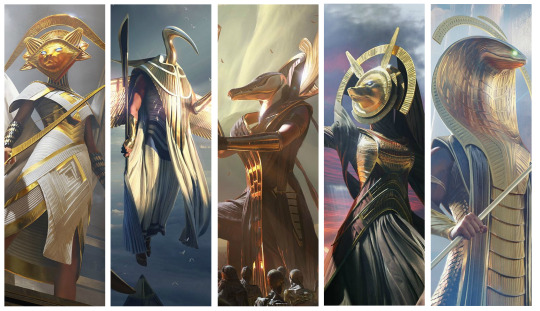
Gods of Amonkhet | Original MTG art by Chase Stone
With the full spoiler unveiled on Friday, we have an inkling of understanding of the limited archetypes that Amonkhet draft and sealed will offer. From the overwhelmingly grinding value of White and Blue’s embalm themes, to Red and White’s aggressive, go-wide with team pumping effects, it remains to be seen how the speed of the format will play, although signs point in the general direction of a slower format.
As with every time new toys are given to the brew-masters and jank-junkies, new combos and archetypes float around Tumblr, either for magical-christmas-land value that kills on turn 3, or the flavor absurdity of a Heart-Piercer Manticore flinging an Aradara Express to the face of an opponent that it also is driving. (thanks to @transreliquat for that amazing visual)
— Liam W, @coincidencetheories
2. Standard Shakeup?
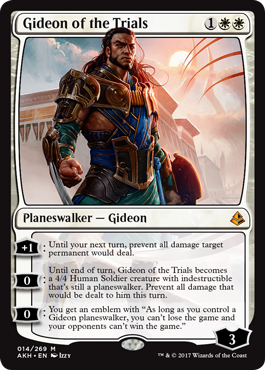
Gideon of the Trials | Original MtG art by Izzy
Amonkhet is in a fantastic position to shake up Standard, providing competent answers to the two menaces of Standard: Mardu Vehicles, and Saheeli combo.
Gideon may have shouldered a ballista into rubble, but Red has the real automotive issues in Amonkhet! Harsh Mentor is a callback to red’s punisher effects of olde, and punishes your opponent for turning their cars on. By force is a fantastic way to eliminate their vehicles, and scales magnificently.
Saheeli cat didn’t get as many options, but the one answer we got for it is absolute. Trespasser’s curse forbids the combo from even going off for just 2 mana. Alternatively, Haze of Pollen can stop it for a turn, and give you an extra turn to take the combo apart.
– Nick D, @nick-dowdle-jeskai-judicator
2. This Week’s Magic Story Review
The Writing on the Wall by Alison Luhrs
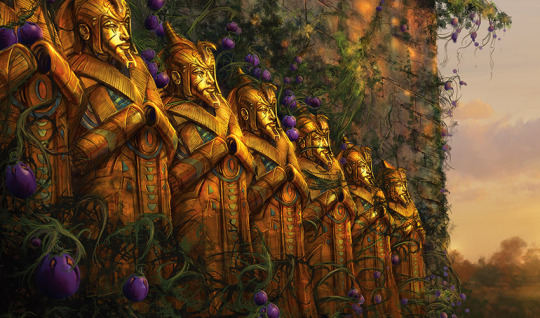
Foul Orchard | Original MTG art by Mark Poole
As the Second Sun inches its way closer to the horns of Bolas on the horizon, the Gatewatch try to make sense of the plane. When we begin the third installment of the Amonkhet story, Nissa has a dream in which she communicates with the soul on the plane. It’s sick, corrupted and crying out for help.
Nissa wakes Chandra up and the two take a walk outside to try and make sense of the city of Naktamun. Everyone seems very young and always training. They encounter Hapatra, who appears to be in her mid 30’s and is the oldest person they’ve seen so far.
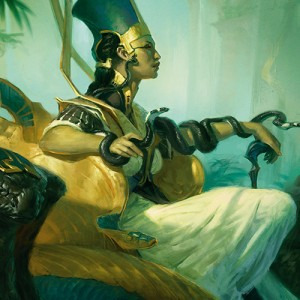
Hapatra, Vizier of Poisons | Original MTG art by Tyler Jacobson
One of the most interesting things they discover are pictoglyphs on an older building. These pictoglyphs tell of the gods of Amonkhet, but instead of the five we know, there are eight gods. Above the glyphs of the eight gods is a more recently made carving of Bolas’s horns. When Nissa confronts Oketra about this, the god’s reaction is possibly one of the scariest things from this storyline so far: “the cat’s ears twitch back in a moment of fleeting, subconscious fear.” When a god is afraid, things are very wrong.
There’s much more in this story. In a bit there’s a whole section about Nissa/Chandra and the post-publication edit one of their interactions received. But there’s also more to be learned about Amonkhetu sarcophagi. For the world building fans among us, this was a super interesting story, where we are left with more questions than we started. Keep your eyes open for hints in artwork and flavour texts. By next wednesday I hope we get some more revelations about Amonkhet’s history.
— Alma V, @hopelessly-vorthosian
3. Gruul-Gate (Chandra x Nissa Discourse)
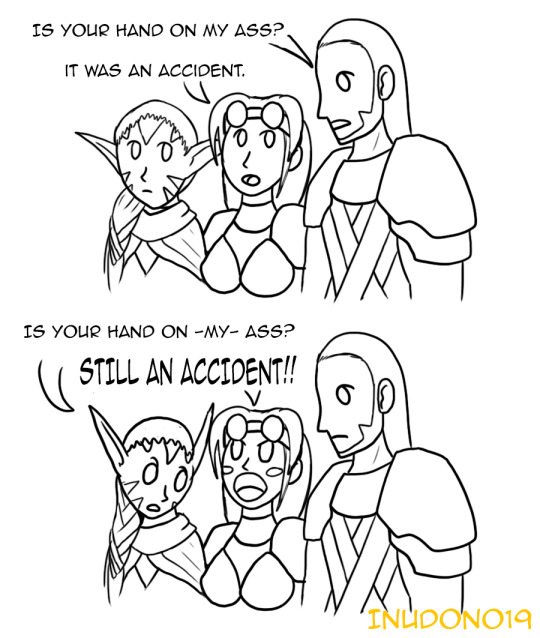
Trash | Art by @inudono
Shortly after the release of the Magic Story on Wednesday, some Tumblr users noticed that the there was some changes to story. The changes were only a few sentences, but it was a conversation between Nissa and Chandra. Originally, the context in the story appeared to hint that Chandra had romantic feelings towards Nissa, but after the second version went up those implied feelings were hard to detect.
The Community responded with confusion at first. @voiceofallmtg was one of the first blogs to make a post about the change, even showing screenshots of the edit. Others, like @suddenlycomics did not want to express panic until there was an official statement from Wizards. All in all, there was a lot of discussion throughout the Community about the edit in the Magic Story. Others, like @bace-jeleren did express mild frustration, but, like the rest of the Community, wanted to hear what Wizards would say.
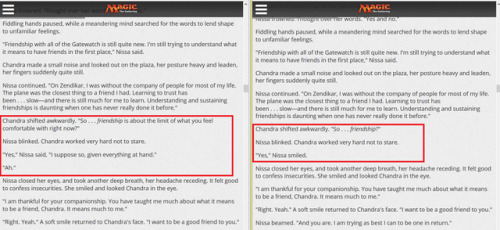
Comparison of the two versions, Original on the left, final/updated version on the right | Picture by @bachelor-biomancer
Other discussions that occurred within the Community were about why the Community was even upset about a change in the story. Some had confusion, thinking that the Tumblr users who ship Nissa and Chandra together were disappointed that their pairing wasn’t canon. In reality, it was about representation and some of the Commuity felt cheated that their possible representation was ripped from them with the edits in the Story. Some Tumblr users, like @the-foxwolf, said that the edit is not as big a deal as the Community was expressing becuase the edit changes nothing about the context of the story.
Later in the day there was an official response from @wizardsmagic that helped to alleviate the confusion and frustration about the edit. Wizards stated that there are multiple versions of Magic Stories during the editing process, and that an earlier version was uploaded by mistake and there was no intent to change the context of the conversation. There was relief from the Community that that it was simply a mistake and it remained true to authorial intent. @flavoracle even expressed that is was a “perfectly reasonable explanation.”
Others however, were still upset about the edit in the story, because it still showed that the hints at LGBT+ representation in the Gatewatch is harder to detect in the new version then it was in the older one. Tumblr user @commandtower-solring-go, who asked the question that got the official response from Wizard, made a post , expressing their disappoint at the cuts, because it leaves out details and that “ the original really does a good job to normalise the idea of non-straight relationships in the multiverse.” All in all, there were a lot of mixed emotions from the Community in regard to the Magic Story change.
What do you, the Community, think? Do you like the original version or the new version better? Do you think there is a change in context, or is the intent of the conversation still there?
— Chelsea W, @chelsea-beleren-vess
4. When It Hits the Fan-Art
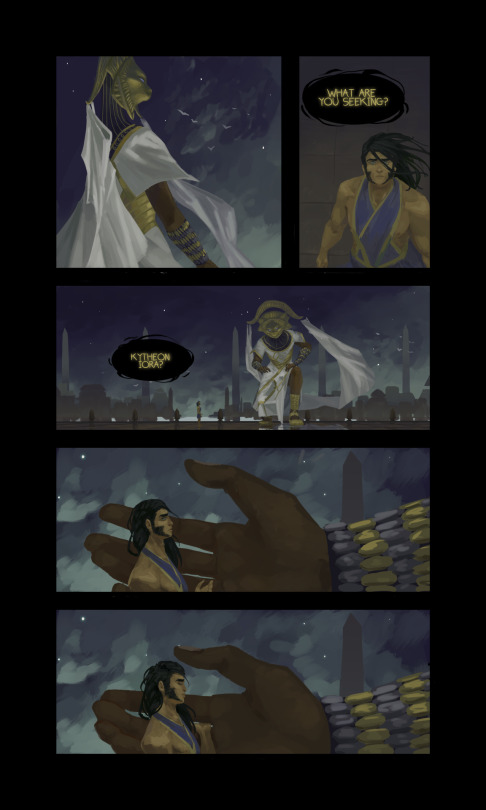
Gideon Seeking | Original art by @oddsbod
It’s painting cats and dogs this week! With all the danger and menace and thrilling action on Amonkhet and the Trials of the Gods, @jakaltimes took on a more sedate subject, the Sacred Cat and the Flameblade Adept. On a similar theme, @sticksandsharks gives an interpretation of Hazoret and Oketra. and from this week’s Magic Story, The Writing on the Wall, @hirafel gives us a short animation of the unexpected breakfast visitor,
The Gatewatch feature heavily this week, with offerings such as @erybiadraws‘s Happy Gideon, @sketchydoodles‘s Amonkhet Nissa, Jace by @0x00fj and a cheeky Liliana, by @circlesmadeofglass
Finally for the retro crowd, we have a series of pixel-art masterpieces from @the-panther4444, looking either like an authentic early 90s dungeon crawler, or possibly MTGO’s latest graphics update.
— Liam W, @coincidencetheories
5. Quoth the RavenMan
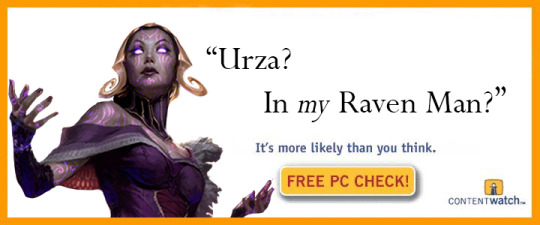
(Source) | @dragons-suck
Late Sunday evening found the Community engaged in a long discussion about the identity of the Raven Man. Naturally, this led to some top-quality memeage. Here is a collection of some of the memes that were created:
Reblog if you think the guy on the left is also the guy on the right
@chelsea-beleren-vess
Is the Raven Man secretly a 1/1 trampler for G?
@kideon
My Raven Man theory, by Chanda-Nalaar
@chandra-nalaar
If anyone here is *not* the Raven Man, please raise your hand.
@phyrexian-without-a-cause
— Compiled by Chelsea W, @chelsea-beleren-vess
5. Manic Scribes
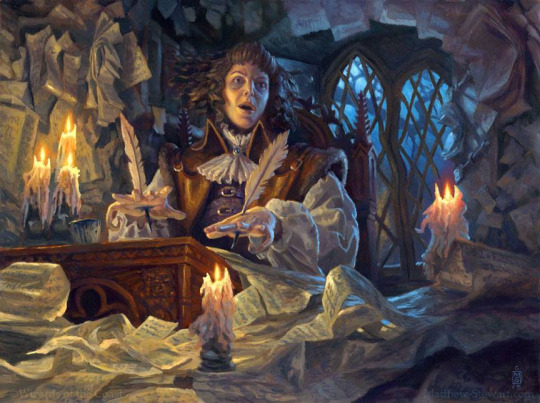
Manic Scribe | Original MTG Art by Matt Stewart
This week, for those looking to hide from all the spoiler seasons mania, here are some articles from around the web that you don’t have to frantically be refreshing pages to see if they’re superseded by the latest new reveal! Top 10 Limited Formats by Mike Sigrist, (ChannelFireball.com) Graveborn Muse: Mind-Altering Substances by Daryl Bockett @gathering-magic examines cards that subtly (or sometimes not so subtly) mess with how the game is played
Why Aren’t There More Women Playing Magic by @not-another-mtg-fanblog
Kolaghan’s Commander by Ryan Sainio @hipstersofthecoast offers some reasons why you might actually play Dragonlord Kolaghan in Commander The Trials of Amonkhet Prerelease by Inkwell Looter, (Magic.wizards.com)
— Compiled by Liam W, @coincidencetheories
…and finally: An Historic Absence?
@askkrenko makes the point that with the absence of Goblins in Innistrad, Kaladesh and Amonkhet, the last Standard legal goblins were released in Oath of the Gatewatch. While there have been absences of varying length before, the regularity of goblins in the core set means that Goblins have always been in standard even before standard was a format (looking retroactively). However, if the currently unknown plane that follows the Hour of Devastation, it is entirely possible that we will have the first Goblin-less standard in Magic history. Perhaps we will find out when announcement day comes in June, perhaps we will remain in suspense…
Thank you again for reading this week’s issue of the MTG Weekly Tumblr Recap. Hope to see you next week!
Interested in contributing to the Recap? Want to keep track of notable posts and trends throughout the MTG community on a given week? Or write a short blurb on a specific topic? Do you just want to make us aware of one specific topic or post? Please PM our main editor @the-burnished-hart or any of our staff writers!
#mtg#mtgwtr#mtg weekly tumblr recap#weekly tumblr recap#amonkhet#amonkhetu gods#oketra#kefnet#bontu#hazoret#rhonas#gideon#liliana#chandra#nissa#gatewatch#mtgfanart#mtg fanart#gruul-gate
64 notes
·
View notes
Text
Fanwalker Friday Asks
Was in a hurry when I made the first AMA post for Fanwalker Friday so here’s take two actually you know, including information so question asking is easier 😅
Anwyn: GBW, lorwyn elf, runs a shop on Ravnica called The Gilt-Leaf Emporium
Ayani: GRU, Nayan elf, big momma bear energy
Cadenza: UG, Fioran elf, an explorer, cartographer, and dashing fencer
Djau: RGW, Amonkhetu khenra, sparked during the Hours and was separated from his twin brother Yuya ( @demonofdankmemes’ khenra boy, he’s really cool!)
Harika: UG, khans timeline ainok, trained in the temple of Kruphix after sparking, now owns a divination shop that mysteriously shifts around the multiverse
Ioanna: WRG, aasimar nyxborn human, Setessan warrior woman bard with starlight freckles
Ishiro: RW, human, demon hunting samurai from Kamigawa, secret soft boy
Isolde: WGU, Bant angel, weirdly balancing a happy domestic life and adventuring around the multiverse
Khaleel: RB, aetherborn, daredevil, pilot, tinkerer, sass master, and fashionista.
Marisol: WB, ixalan vampire, big Joan of Arc energy, branded a heretic for going against the queen and burned at the stake, sparking when the immortal sun was stolen in the luckiest sparking ever
Mizuki: UGW, soratami, tiny bunny mom, travels the multiverse to study and record histories and cultures
Petra: WR, Boros angel, doesn’t even fully understand she’s a planeswalker now god bless her
Reiner: WUR, human/angel? It’s complicated?, former midnight duelist, currently a private investigator on Ravnica
Rune: RU, azra, arena competitor and prankster, loves mischief and his dumb Orzhov boyfriend
Winnith: GUR, human, inherited her spark from her grandmother, very Witchy™️, will not hesitate to turn you into a frog if you’re a bully
Zenya: BRW, zendikar vampire, likes hunting other vampires, partying hard, and being cooler than the rest of us
5 notes
·
View notes
Text
Name: Qarisi (formerly Kherehet)
Pronouns: She/her
Species: Naga
Plane of Origin: Amonkhet
First Planeswalk: Tarkir
Colors: Green/Black/Blue
Appearance:

(Art by @land-ofthebooty)
At over 50 years old and 36 feet (11m) long from nose to tail, Qarisi is an extremely muscular naga with olive green scales, thick blue stripes, and a sandy gold underbelly. Her broad hood is patterned with blue stripes reminiscent of the Dissenter’s Sarcophagi, and a long gash bisects her right hood from edge to right up against her neck (her only major scar from the Trials).
Backstory: Possibly the strongest naga ever born on Amonkhet, Qarisi was a prodigy who fought and killed her way to victory as part of one of the very first crops of Initiates after Bolas became God-Pharaoh. Before Hazoret’s spear could land its fatal blow, the sheer joy of completing her life goal ignited her spark, launching her to the plane of Tarkir.
On Tarkir, Qarisi pursued more cerebral pursuits, including mind magic and minor necromancy, and had a whirlwind romance with a local naga named Sidisi. When an interrogation of a monk’s memories showed her Nicol Bolas’ place in Tarkir’s history, Qarisi realized the awful truth of her situation. Forsaking her Amonkhetu name, Kherehet, for a Tarkiran approximation, she swore vengeance on the false God-Pharaoh and set out to spend the rest of her life researching his actions and weaknesses, intent on finding a way to beat him, kill him, or watch him suffer for what he did to her world.
Now based on Ravnica, Qarisi maintains a small private investigative business and keeps in contact with scholars on most planes Nicol Bolas has visited to keep tabs on his history. She also moonlights as a fighter at Valor’s Reach on Kylem, under the ring name “Queen Cobra.”
Personality: Qarisi’s ego is as big as she is: very, by several metrics. She is hyper-competitive, always eager to prove her superiority against anyone who says they could best her in her fields of expertise. She offers motherly guidance based on her own experiences to anyone who she thinks needs it… Unfortunately for them, her life on Amonkhet has completely inured her to death, giving her a black sense of humor and strange sense of ethics that others may find off-putting.
Magic, Gear, Abilities: For most of her life on Amonkhet, Qarisi only practiced the bare minimum magic required to pass the Trials. On Tarkir, she learned the magics of psychic assault and mind reading. Her abilities lie mostly in the physical realm. Whip-fast, deadly accurate, and strong enough to deadlift a sandstone obelisk, Qarisi doesn’t need a weapon to kill or maim most opponents in a matter of seconds. If she does have a weapon, she prefers her old Trials-tested glaive, made from a long staff and a two-handed sword styled like the Usurper’s horns, which she wields like a massive spear. Her most prized possessions are her complete set of Trials cartouches, documenting her complete mastery of the Trials.
Card:

(You can find her rp blog at @qarisi !)
7 notes
·
View notes
Text
Identifying Dragons: Amonkhet
Amonkhet is unforgiving. Its deserts are filled with undead, cursed to walk forever until only their bones remain. Everything took a turn for the worse for the plane's last known city, Naktamun, when the Second Sun aligned between the horns on the horizon. The Luxa's waters turned red with blood. Forgotten gods rose to spread chaos. The Hekma was torn down. Venturing out among the dunes was the only way out of the devastation.

Ramunap Ruins by Florian de Gesincourt
Beyond the barrier are innumerable monstrosities. Among them are the plane's dragons.
What to Expect

Glorybringer by Grzegorz Rutkowski
Amonkhetu dragons are large, ferocious creatures with crocodilian characteristics.
Head: Amonkhetu dragons have a crocodilian head, with a long snout and jaws lined with sharp teeth, in addition to the ridges that start near their eyes. A short, thick neck connects the head to the body.
Limbs: Amonkhetu dragons' limbs appear shorter than those of dragons from most planes. Their fingers are short but end with sharp claws.
Body: Reddish scales and scutes cover their bodies, with the undersides having a much paler color. The line of ridges that start from their heads continue along their backs and end at their tails. Those used in the trials are fitted with shining, ornate armor.
The Trespasser

Nicol Bolas, God-Pharaoh by Raymond Swanland
In the world of Amonkhet, elder dragon Nicol Bolas had another title: God-Pharaoh. The people and gods revered him as they aspire to be worthy of a glorious afterlife. However, the inscriptions on the old walls identify him differently. In reality, he is the Great Trespasser who brought upon a sudden genocide of Naktamun's older generations and an upheaval and repurposing of Amonkhetu belief and culture for his own ends.
Dangers

What the initiates face in the final trial is completely at Hazoret's discretion.
Glorybringer by Sam Burley
Breath weapon: fire
Most Amonkhetu dragons live in the wilderness, content to fly and hunt freely over the sands. Sometimes one is captured and brought into the city. Within, they have one fate - to be put into the trials by the gods. Creatures such as dragons, with their savagery and might, prove to be appropriate obstacles. Besides the best initiates locked in battle against each other, Hazoret's Trial of Zeal in particular usually feature an armored dragon to test the combatants even further.

Initiates need worry only about the trials. Everything else is in the hands of the gods.
Lay Claim by Chris Rallis
These dragons are more feral than intelligent. Facing one within the confines of the Hekma outside of the trials was probably impossible given the gods' diligent watch over the populace. Encountering one in the desert is another matter altogether, though sandwurms and zombies would be more common threats. Now, with most of the gods dead and the Hekma gone, all the creatures of the desert are free to roam anywhere. If doom doesn't come from the dunes, it will probably land from the skies.
46 notes
·
View notes
Text
Let’s Talk About the Hour of Revelation
Magic Story is Back! And there is SO MUCH to talk about. As usual, I HAVE THINGS TO SAY. Alison Luhrs is on fire with this story.
Welcome to Nicol Bolas, people.

Art by Raymond Swanland
He had days. Only days until he wouldn't have the magic left to execute this plan. There was just enough time left to put into place the possible means to regain his godhood.
The dragon's plans spanned millennia and his perception straddled centuries, a winding maze of possibility and circumstance and statistics and likelihood. Usually the dragon played the odds when shaping his decisions—but now, to manifest his needs, the dragon would need to be violent in his choices.
Okay, so this is obviously just a short time days after the Mending. The Mending didn’t change everything all at once, but planeswalkers were still depowered relatively quickly.
@sarpadianempiresvol-viii pointed out to me that his haste explains why so much of Amonkhet’s true history remained. There wasn’t time to erase everything.
The gods of Amonkhet saw the dragon hovering outside the protection of the Hekma.
So the Hekma was there before Bolas. Bolas isn’t responsible for the Devastation outside of Naktamun. Interesting.
They were determined not to fail this time. No monster could defeat the eight gods of Amonkhet. Not when Naktamun was all that remained.
This is VERY interesting. They didn’t fail this time? So whatever happened to Amonkhet, the gods couldn’t prevent it. The implication here is that Bolas showed up and took advantage of the situation, not that he destroyed all of Amonkhet. But why the reference to him in the Broken Lands? Maybe he is responsible for more, but the way the intro is written, it doesn’t seem that way.
Edit: So while writing this, I’d been having a twitter back and forth with Alison, and she confirmed this wasn’t intended to read like I’m suggesting:
Its more of a 'this time when it counts' not 'this time UNLIKE A MYSTERIOUS LAST TIME DUN DUN DUN'.
But still, with the Curse of Wandering, perhaps we’re looking at a long-term attrition on the plane, and that’s what the gods are referring to. This marks Bolas’ initial arrival (or at least, him carrying out his plans).
The gods' distraction to protect the mortals amused the dragon. These gods cared far more about their plane than he ever did about the worlds he created.
Bolas confirmed bad dad. But the gods - all the gods - of Amonkhet are genuinely good, it seems.
Kefnet, caretaker of the Hekma, was straining to keep the magical barrier together. The dragon tipped his chin and fractured Kefnet's mind in two.
Kefnet's body and wings went limp and he plummeted to the ground, crumpled and still.
Kefnet. Kefnet? KEEFFFNEEEET!?!?
Man, I wish Rhonas had taken the hit so I could make a MGS Game Over reference easier
A brilliant white light engulfed Naktamun, and the seven gods fell to their knees in agony as countless souls vanished from existence.
Notice how it says seven now? Perhaps there were once more than eight gods of Amonkhet, but others were killed before Naktamun. Or maybe we’ll just have to deal with uneven cycles, but it hurts my brain.
The dragon opened his eyes and every mortal old enough to walk dissipated into the sky.
Um. Bolas just unsummoned tens of thousands of people. This is old-school Nicol Bolas. This is power, even for Oldwalkers.
The dragon burst through the mausoleum door. Oketra and Hazoret charged. With a wave of a claw, the dragon sent forward a pulse of magic, and the minds of the two gods went utterly blank.
They fell where they stood.
Oketra and Hazoret running to protect the children was the most beautiful thing. I honestly always thought “You’ll understand when you have children.” was a stupid reason, but these kinds of things hit me way harder now that I have a son than it did beforehand.
First, he returned to the surface and took three of the gods for his own. He stowed them away as one would tools in a cupboard. Their time would come soon enough. With his remaining power, the dragon corrupted and manipulated the leylines of mana that coursed through the remaining gods, willing them to forget their origins, tying their existence to himself, and forcing them to erase all else.
So those three have been off the board, likely hidden behind the Gates to the Afterlife.

Sup.
There existed an elite religious ceremony—trials of merit, with the result being a single sacrificial champion every revolution of the second sun. A rare cultural cornerstone revered by both man and god. Perfectly suited to repurpose for his designs. The dragon rejoiced at the convenience. What had occurred once every few decades would now demand a constant supply of champions. He spelled the second sun to move as he was ready, to count down until whenever he decided to return. This would be the cornerstone of his machinations on this world.
Okay, so Amonkhet DID have sacrificial trials before, but there was only ever one sacrifice. And it happened once every few decades, not every year.
Amusingly, there’s a lot of champion talk here for one who hates champions now. Maybe this whole plan is because he doesn’t want another champion to turn on him but still wants and army.
On the other side of the barrier, he erected a monument in his own visage, an homage to his magnificent horns, and enchanted it to appear stationary from every angle. He built the monument to frame the smaller sun on the horizon at the moment of his choosing. The dragon was proud. Vanity is survival when one is rapidly losing omnipotence.
Haha, Bolas created an optical illusion. That’s why they seem to show up everywhere. This is the best possible explanation - the horns show up in all the art because Bolas enchanted them that way.
From afar the dragon maintained, monitored, and moved his machinations on other worlds as the years fell away, urging the second sun slowly around its track
OKAY THIS IS IMPORTANT. Nicol Bolas controlled the second sun. My biggest gripe about the Planar Bridge theory for Bolas’ Army? Solved. The Hour of Revelation isn’t at hand because Bolas set an egg timer 60 years ago and walked away. He’s been inching it closer as his plans came to fruition. So it’s the Hour of Revelation NOW, directly after Aether Revolt, BECAUSE Tezzeret acquired the Planar Bridge.
The only thing he could see beyond the Gate was a building that could only be the Necropolis—the fabled place where the worthy dead were laid to rest, awaiting the return of the God-Pharaoh.
And there’s your Crumbling Necropolis reprint right there. I was wondering if this would get in. Looking forward to an Amonkhet variant. Or maybe it’ll be a new Necropolis with a desert sub-type.

The demon stood high atop the obelisk and spread its wings to catch the warmth of the second sun. Djeru could make out a crocodilian form and a mad smile. Endless scales ending in a thick tail. Sharp wings leading toward a sharper grin.
I was never very sure about Razaketh’s design, but he looks awesome.

Art by Slawomir Maniak

Art by Jaime Jones
I would even venture to say he looks Draconic. Djeru says crocodilian, but Amonkhetu Dragons are crocodilian. It’d be interesting, because that would make both Bolas-centric blocks feature a demon dragon working for Bolas.
@sarpadianempiresvol-viii suggests that maybe Razaketh is partly behind the gradual attrition of Amonkhet, and he’s working with Bolas because Bolas agreed to give him final dominion over the plane when Bolas is done.
Also, it’s hard to gauge Razaketh’s size from these, but he seems big.
And as the blood began to spread, leak, stain the brown-green-blue of the Luxa River, the brilliant wash of red began to eek upriver.
Yup. They definitely aren’t doing Exodus, people. Nothing to see here. We definitely won’t be seeing all the plagues of Egypt.
"I know you are here, Liliana Vess. You cannot hide from me."
*shivers* This story was excellent. Probably one of the best since Magic Origins, top five at least.
So what is Bolas up to? I’m still pretty firmly in camp Lazotep creatures, although I think they’re being made into Horrors with the powers instead of some kind of artifact-y creature. Umezawa and Tezzeret have proved thinking minions are unreliable at best. I’m hoping there’s more to it, yet. What is Bolas’s end game?
192 notes
·
View notes
Text
some prayers/epithets for Amonkhetu gods i made up just now
Dua Oketra! Lady of Solidarity, Guardian of the Truth! May your Love shield me and your Arrow pierce through the darkness!
Dua Kefnet! Lord of Knowledge, Guardian of the Mind! May your Wings encase me in your wisdom, and your Hekma keep all darkness at bay!
Dua Bontu! Lady of Ambition, Guardian of the Glorified! May your Ambition flow through me, and your Roar destroy the monsters of the dark!
Dua Hazoret! Lady of Zeal, Guardian of the Fervent! May your Energy flow through me, and your Spear defeat all foes!
Dua Rhonas! Lord of Strength, Guardian of the Indomitable! May your Menagerie accompany me, and your Staff turn all foes to allies!
Dua, Shadow Gods! Your old forms are lost, forever changed. May they rest in eternal peace. May your new forms help you assist your followers.
Dua, Scorpion God! Lord of Rage and Killing! May you destroy all foes who dare oppose you!
Dua, Locust God! Lord of Many and Dissolution! May you dissolve all barriers that might stop you!
Dua, Scarab God! Lord of Undeath and Rebuilding! May you fortify all who come to you, and protect those in Death!
7 notes
·
View notes
Note
rate the amonkhetu gods from most to least datable
1. Oketra2. Hazoret 3. Kefnet4. Bontu 5.

29 notes
·
View notes
Text
Favourite Amonkhetu Flavour Texts
Lay Bare The Heart “True intentions lie not in the head but in the heart.” -- Bontu, god of ambition
For the reference to the Egyptian belief that the heart is the seat of all thought.
Electrify “Some hid from the storm. I embraced it and learned its name.”
In Egyptian belief, words were what created the land, and names gave it countenance. A name is, in essence, a magic uttering. To know a (true) name, be it that of a demon or a deity, is to be able to exert a certain power over it.
Throne Of The God-Pharaoh "When the Second Sun rests between the horns on the horizon, so begins the Hour of Revelation. Then the Hour of Glory, the Hour of Promise, and finally the Hour of Eternity." -- The Accounting of Hours
A clear reference to the Amduat, and specifically those of the 21st Dynasty onward, which accounted for only the final four hours of the night (though I admit that may be a coincidence).
148 notes
·
View notes
Text
I don’t think it’s ever stated in “Endure” which arm Hazoret amputated, but I’m assuming it was her non-dominant hand, considering how well she was holding up without it.
(granted, that’s assuming a literal god has a dominant and non-dominant hand, but the Amonkhetu gods have been portrayed as very large, very powerful humanoids with non-shifting physical forms - hence a god being able to amputate her own arm and seemingly have that loss stick - so it’s not that much of a stretch...look this is a hypothetical thing just roll with it okay?)
so under that assumption, based on her card art Hazoret seems to be a lefty, which means that she cut off her right arm.
...basically this is just a long-winded of saying The Right-Arm Curse Strikes Again.
1 note
·
View note
Text
Maine Worships a Birb
i await my Amonkhetu god; Kefnet the Mindful, the Careful, the Knowledgable. may his feathers be tidy and preened.
i was gonna try to build a blue-white Amonkhet deck, but i really didnt want to focus on mummies. yet. not until Hour of Devastation. so instead, ill be pairing the Great Birb with Kruphix!
11 notes
·
View notes
Text
Amonkhet, Egyptology and the difficulty with ‘AKHonography’
Since I’m seeing a lot of people comment on my (and others’) posts about the history and facts behind Amonkhet with roughly the same things, I’m going to explain my perspective here. I will also touch upon the difficulty of interpreting Amonkhetu iconography, which I’ll call, and tag as AKHonography because what good is being an Egyptologist if you can’t make incredibly on point and clever contractions.
I will briefly pause for applause and admiring gasps for breath before I move on.
“Amonkhet is not real Egypt. We can’t expect it to adhere to the original mythology.”
Without going into detail about how the term “original mythology” as it pertains to Egyptian history is a far more complicated matter than you think it is, this is correct. Amonkhet is not Actual Egypt™. I am aware of this and I have always been. In fact, in one of my first tweets after Amonkhet was announced I specifically stated that all my comments should be viewed in the light of Egyptology and that Amonkhet does not necessarily adhere to these nor does it have to.
When I spoke to (part of) the concept team during GP Rotterdam last year, this was also one of the first things they told me - with considerable trepidation on their faces because I mentioned my professional background, bless them. Titus Lunter says that all the research they did was not to copy Egypt into Amonkhet; rather to make it invoke Egypt, in a Magic: the Gathering way.
With that being said, what is my intent in commenting on Amonkhetu aspects and tying it to Egyptian history, culture, mythology, iconography and/or philosophy?
Inform; I love talking about ancient Egypt and sharing my knowledge. My main intent is to elaborate on those things I find interesting and answer the questions you guys might have about Egyptian history based on things you see in Amonkhet.
Research; Which parts of the culture, history and iconography of Egypt did the concept team use to shape Amonkhet? How did they implement these? What was their idea in using or not using aspect X?
Entertain; I’ve been somewhat undeservedly slated as The Expert when it comes to the Egyptian background of Amonkhet. However, a lot of people seem to enjoy my Twitter threads and occasional rant, and that’s enough for me.
“WotC operates on the audience’s expectation and perception of X, not necessarily the reality and facts.”
While this may be correct, I do think it does a disservice to the concept team: From what some of them told me I can deduce that they’ve done an actual ton of research to make sure that they were able to give as best a representation of ancient Egypt within Amonkhet as they could. The amount of books and sources Titus went through to get the architecture down pat is staggering, and the boats being so evocative of ancient Egypt is thanks to Tyler’s research in the matter.
I’m not implying that everything they do in Amonkhet is per definition great. Faulty research can lead to wrong assumptions. Experts can be incorrect. There is a really fine line between being inspired by and just dousing something in an “Egyptian-y” sauce without respect for the source material and calling it a day.
I will have my personal preferences and/or doubts about how and if they implement certain elements. While I’m not going to say that X is objectively wrong according to all possible parameters because it is not “really Egyptian”, I have been specifically asked to give feedback on errors and mishaps I find.
In short, you should keep in mind that when I comment on e.g. my dislike of winged sphinxes, or equating Anubis with the Western perception of “death gods” and his subsequent characterisation as (possibly) mono-black, this is from my personal knowledge of Egyptian mythology and not because I think Amonkhet should adhere to Dynastic Egypt on all accounts. I’m perfectly aware of the archetypes in use in Magic: the Gathering. This doesn’t mean I can’t have my Egyptological doubts, however.
Interpretation difficulties
When I started studying Egyptology, I thought I already knew a fair bit through self-study. This idea was bricked out of my brain about .2 seconds after arriving at university on my first day of classes.
Most of what you think you know is either outdated, incomplete, or doesn’t pertain to the whole of Egyptian culture.
There is no shame in this - Egyptology as a science is constantly evolving and adapting, and the history of Egypt itself spans such an incredible amount of time that it’s nigh impossible to be an expert on every single aspect of that culture and history. Moreover, most of the knowledge easily accessible through internet sources or found in pop culture is from the latest periods in Dynastic history: i.e. the New Kingdom and the Late/Graeco-Roman Periods, and stems from the upper classes/elite more often than not.
When I look at the references in Amonkhet, I have to take this into account. I don’t expect the concept team to have studied 10+ years in order to create an accurate-on-all-accounts plane inspired by a single period in Egyptian history. Anachronisms are going to happen, e.g. that the Amonkhetu build pyramid-like structures (a mostly Old Kingdom thing) during a time they also use the khepesh sword (in use from the New Kingdom onward).
This presents considerable difficulty, not in the least because I can’t by far be as nuanced as I’d like to be in Twitter threads. Please keep this in mind at all times, and remember I’m open to discussion and/or questions on Egypt, Amonkhet-related or not.
AKHonography goals
What I endeavour to do with my posts on AKHonography is to point out the references I think they used, and give you a background on those references. At times my posts will be coloured by my personal perception. I’m only a human with distinct tastes and ideas, after all. A glance into the culture and iconography of Ancient Egypt is what I offer you.
Disclaimer: I am in no way affiliated with Wizards of the Coast, and none of my substantive comments should be taken as hard evidence for or against X. I was neither consulted nor have I been given any inside information by any party. Any views or doubts I express are my own. All ‘knowledge’ of Amonkhet so far is garnered through personal research and speculation and everyone is free to agree or disagree. I am planning more in-depth talks with members of the concept and worldbuilding/creative teams once spoiler season starts and they’re allowed to give that kind of information.
#mtg#mtgakh#amonkhet#akhonography#magic: the gathering#I'm not sub-blogging or trying to call anyone out on comments btw#it's just easier to gather all this together into one post instead of explaining it in 38529 reblogs
138 notes
·
View notes
Text
More Speculation Time!

The Gods of Amonkhet!
How to represent flavorfully and mechanically the awesome power of a God?


Wizards did a fairly masterful job of designing the Therosian Gods, at the very least on a macro level with the devotion mechanic. The way the gods always provided valuable enchantment effects, and occasionally became these beefy bonus creatures. With the power of belief so crucial on Theros, the task of winning over a God’s favor to not only bless your fight but to fight on your behalf represented by how many of their color mana pips were on your side of the battlefield was so perfect a mix of meaning and symbolism, that it’s hard to imagine any other way.
So let’s try and thing of another way. The gods of Amonkhet! There is a certain weight of expectation, I feel, for the Gods (If, and we actually have not had it officially confirmed, these colossal creatures are Gods) to have a similar feeling of grandeur and mystery. And I think if the flavor is properly presented, the mechanics can differ to fit, I consider some of the mechanical traits of the original pantheon to have a less than zero amount of cachet. With that in mind, a couple of ideas of how the Amonkhetu Gods might appear to us: -Simply the reverse of the Theros Gods. Coming down these are just large, probably indestructible creatures. However, reach a particular threshold (perhaps amount of cards in your graveyard, or a number of creatures dying in a turn, or cards in hand) and suddenly an enchantment-like effect is switched on. -Graveyard Enchantments. Similar to effects like Anger, Genesis and others,

The gods will provide beneficial effects while in the graveyard (with sufficient support in either discard, self mill or unearth-like tutoring into the graveyard) and perhaps when another threshold is reached, they can be brought from the graveyard and become creatures.
-Ready to fulfill their potential. With some flavour justification, they come in with an amount of -1/-1 counters on otherwise robust creatures with beneficial effects. You, the planeswalker have to complete ordeals or trials to meet the requirements to lose those counters, unleashing the full fury of a god. -Defenders of the universe. A boring thought, but they could just be big creatures with defender and they lose defender when X number of Y are on the battlefield or condition A has happened N number of times. Let’s hope not.

I have all faith and no doubt that the R&D team have broader and better understanding about how to make these gods both similar, yet distinct from their predecessors. I’m looking forward to Amonkhet, with a new story only a few 2 more weeks away! and previews hot on the heels of that!
32 notes
·
View notes
Text
I really really hope Bontu didn't betray the other Amonkhetu gods. We had that already with Tasigur.
1 note
·
View note
Photo

DRAGON SPOTTED
AMONKHETU DRAGONS AAAHHHHH
Let’s see here... Large, long head, short forelimbs. Probably long body? I’m getting a Theran dragon vibe with more head than neck here. If Kaladeshi dragons are tigers with wings, imagine Amonkhetu dragons to be crocodiles with wings. Of note is the armor covering our dragon here. An almost complete disk attached to a striped neckpiece reminiscent of a nemes headdress, more Bolas symbols, trailing banners, bracers. A guardian creature, a god’s scourge, or maybe both?
13 notes
·
View notes
Text
Archenemy: Nicol Bolas Art Analysis
Where to even start! With the contents of Archenemy: Nicol Bolas revealed at last, it seems we’ve gotten our first glimpse at Hour of Devastation.
The God-Pharaoh’s Gift
Bolas’ Plan Revealed
Since I’ve already talked a bit about it, but I want to highlight three pieces of art. Let’s start with the Horror token, which shows up in today’s Game Knights video about the product.

Here we see what was clearly once an Amonkhetu Minotaur. It’s not one of the Wandering Dead, and it was clearly was ceremonially embalmed and wrapped. Whether it was a Worthy or an Anointed, I don’t know. I still think the Worthy will get the full Lazotep treatment, while maybe the Anointed are transformed into these horrors along with the Wandering Dead. It’s clearly been mutated, and with that blue eye glow I think it’s been Lazotep powered-up, at least partially explaining those mutations. Hopefully we’ll know more specifics soon! I really want to get these tokens in my decks.
The rest after the break, but I’ve got a LOT of images, so prepare yourself.
Delight in the Hunt by Titus Lunter

We’ve got four figures here, all likely Horrors from the Broken Lands. From left to right, there’s a small head there that must be attached to something, but what I’m not sure. It looks like a giant goblin head. Above it and slightly to the right is one we’ve seen before: a Grim Strider.

Grim Strider by Christine Choi
Next to that one appears to be some kind of Set-Animal Horror (or maybe even a god). The set-animal is an amalgam that was used almost exclusively to represent the god set. You can see it below, and given the shout-out to Ammit before, I really think this might be our Set-Animal reference.

The final one to the right seems to be a huge version of a Horror of the Broken Lands.

Horror of the Broken Lands by Daarken
Power without Equal by Christine Choi

Finally we get to what are the likeliest candidates for the three missing gods.
On the far left, the figure looks a bit like what I had assumed would be a Worthy back in my piece on the God-Pharaoh’s Gift. They’re similar, but I’m not positive about it either way. The staffs are different.

In the center we see what I’ve been affectionately thinking of as beefcakes. This hulking figure looks like he’s got a stinger behind him (or maybe a giant sarcophagi), and you can also see him in the art for A Reckoning Approaches... which, by the way, shows the Gate to the Afterlife open. And what lies beyond is terrifying.


Although given that we know Razaketh guards the Gate to the Afterlife, it seems like we should see Razaketh... guarding them, right? I’ve seen speculation that this is hulking figure is Razaketh from Beck Holden of Hipsters of the Coast. The problem is that we already know what Razaketh looks like, and this would be a huge redesign.

Or would it? If you remember, I speculated that the dead gods had already been Lazotep infused. We know from Servants that Razaketh has something to do with the Anointed, and seems to be able to directly control them through their Cartouches. It’s not a stretch to think he’s in control of the dead gods, and while he isn’t physically present, he’s still guarding the gates through Beefcakes.
It’s worth noting you can vaguely make out horns on Beefcakes, maybe it is indeed the Ram God I wished for in The Lost Gods of Amonkhet. Perhaps, given it’s the first thing we see beyond the gates, that this is the god responsible for the Hour of Revelation. It’s revealed that ‘whoops, we’re all F*****d!’
The third and final figure on the right has their weight and legs balanced in such a way that they seem to be reverse jointed. Perhaps this is the other Bird god we know exists (as the mural Nissa found is describes gods that look like birds, plural). It’s also the vaguest figure so there isn’t much else to learn from it, except that it’s proportioned differently.
If these were former gods of Amonkhet, it’s likely that they’ve been transformed much like the plane’s people in to servants of Bolas.
46 notes
·
View notes